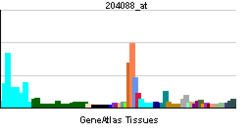- P2RX4
-
P2X purinoceptor 4 is a protein that in humans is encoded by the P2RX4 gene.[1][2]
The product of this gene belongs to the family of purinoceptors for ATP. This receptor functions as a ligand-gated ion channel with high calcium permeability. The main pharmacological distinction between the members of the purinoceptor family is the relative sensitivity to the antagonists suramin and PPADS. The product of this gene has the lowest sensitivity for these antagonists. Multiple alternatively spliced transcript variants have been identified for this gene although their full-length natures have not been determined.[2]
Contents
See also
References
- ^ Garcia-Guzman M, Soto F, Gomez-Hernandez JM, Lund PE, Stuhmer W (Feb 1997). "Characterization of recombinant human P2X4 receptor reveals pharmacological differences to the rat homologue". Mol Pharmacol 51 (1): 109–18. PMID 9016352.
- ^ a b "Entrez Gene: P2RX4 purinergic receptor P2X, ligand-gated ion channel, 4". http://www.ncbi.nlm.nih.gov/sites/entrez?Db=gene&Cmd=ShowDetailView&TermToSearch=5025.
Further reading
- North RA (2002). "Molecular physiology of P2X receptors". Physiol. Rev. 82 (4): 1013–67. doi:10.1152/physrev.00015.2002. PMID 12270951.
- Maruyama K, Sugano S (1994). "Oligo-capping: a simple method to replace the cap structure of eukaryotic mRNAs with oligoribonucleotides". Gene 138 (1–2): 171–4. doi:10.1016/0378-1119(94)90802-8. PMID 8125298.
- Garcia-Guzman M, Stühmer W, Soto F (1997). "Molecular characterization and pharmacological properties of the human P2X3 purinoceptor". Brain Res. Mol. Brain Res. 47 (1–2): 59–66. doi:10.1016/S0169-328X(97)00036-3. PMID 9221902.
- Suzuki Y, Yoshitomo-Nakagawa K, Maruyama K, et al. (1997). "Construction and characterization of a full length-enriched and a 5'-end-enriched cDNA library". Gene 200 (1–2): 149–56. doi:10.1016/S0378-1119(97)00411-3. PMID 9373149.
- Korenaga R, Yamamoto K, Ohura N, et al. (2001). "Sp1-mediated downregulation of P2X4 receptor gene transcription in endothelial cells exposed to shear stress". Am. J. Physiol. Heart Circ. Physiol. 280 (5): H2214–21. PMID 11299224.
- Glass R, Loesch A, Bodin P, Burnstock G (2002). "P2X4 and P2X6 receptors associate with VE-cadherin in human endothelial cells". Cell. Mol. Life Sci. 59 (5): 870–81. doi:10.1007/s00018-002-8474-y. PMID 12088286.
- Strausberg RL, Feingold EA, Grouse LH, et al. (2003). "Generation and initial analysis of more than 15,000 full-length human and mouse cDNA sequences". Proc. Natl. Acad. Sci. U.S.A. 99 (26): 16899–903. doi:10.1073/pnas.242603899. PMC 139241. PMID 12477932. http://www.pubmedcentral.nih.gov/articlerender.fcgi?tool=pmcentrez&artid=139241.
- Yamamoto K, Sokabe T, Ohura N, et al. (2003). "Endogenously released ATP mediates shear stress-induced Ca2+ influx into pulmonary artery endothelial cells". Am. J. Physiol. Heart Circ. Physiol. 285 (2): H793–803. doi:10.1152/ajpheart.01155.2002. PMID 12714321.
- Yeung D, Kharidia R, Brown SC, Górecki DC (2004). "Enhanced expression of the P2X4 receptor in Duchenne muscular dystrophy correlates with macrophage invasion". Neurobiol. Dis. 15 (2): 212–20. doi:10.1016/j.nbd.2003.10.014. PMID 15006691.
- Yang A, Sonin D, Jones L, et al. (2004). "A beneficial role of cardiac P2X4 receptors in heart failure: rescue of the calsequestrin overexpression model of cardiomyopathy". Am. J. Physiol. Heart Circ. Physiol. 287 (3): H1096–103. doi:10.1152/ajpheart.00079.2004. PMID 15130891.
- Brown DA, Bruce JI, Straub SV, Yule DI (2004). "cAMP potentiates ATP-evoked calcium signaling in human parotid acinar cells". J. Biol. Chem. 279 (38): 39485–94. doi:10.1074/jbc.M406201200. PMID 15262999.
- Fountain SJ, North RA (2006). "A C-terminal lysine that controls human P2X4 receptor desensitization". J. Biol. Chem. 281 (22): 15044–9. doi:10.1074/jbc.M600442200. PMID 16533808.
- Jelínková I, Yan Z, Liang Z, et al. (2006). "Identification of P2X4 receptor-specific residues contributing to the ivermectin effects on channel deactivation". Biochem. Biophys. Res. Commun. 349 (2): 619–25. doi:10.1016/j.bbrc.2006.08.084. PMID 16949036.
- Solini A, Santini E, Chimenti D, et al. (2007). "Multiple P2X receptors are involved in the modulation of apoptosis in human mesangial cells: evidence for a role of P2X4". Am. J. Physiol. Renal Physiol. 292 (5): F1537–47. doi:10.1152/ajprenal.00440.2006. PMID 17264311.
External links
Ionotropic glutamates Ligand-gated onlyVoltage- and ligand-gated‘Orphan’ATP-gated channels B trdu: iter (nrpl/grfl/cytl/horl), csrc (lgic, enzr, gprc, igsr, intg, nrpr/grfr/cytr), itra (adap, gbpr, mapk), calc, lipd; path (hedp, wntp, tgfp+mapp, notp, jakp, fsap, hipp, tlrp) Categories:- Human proteins
- Membrane protein stubs
- Ion channels
Wikimedia Foundation. 2010.

